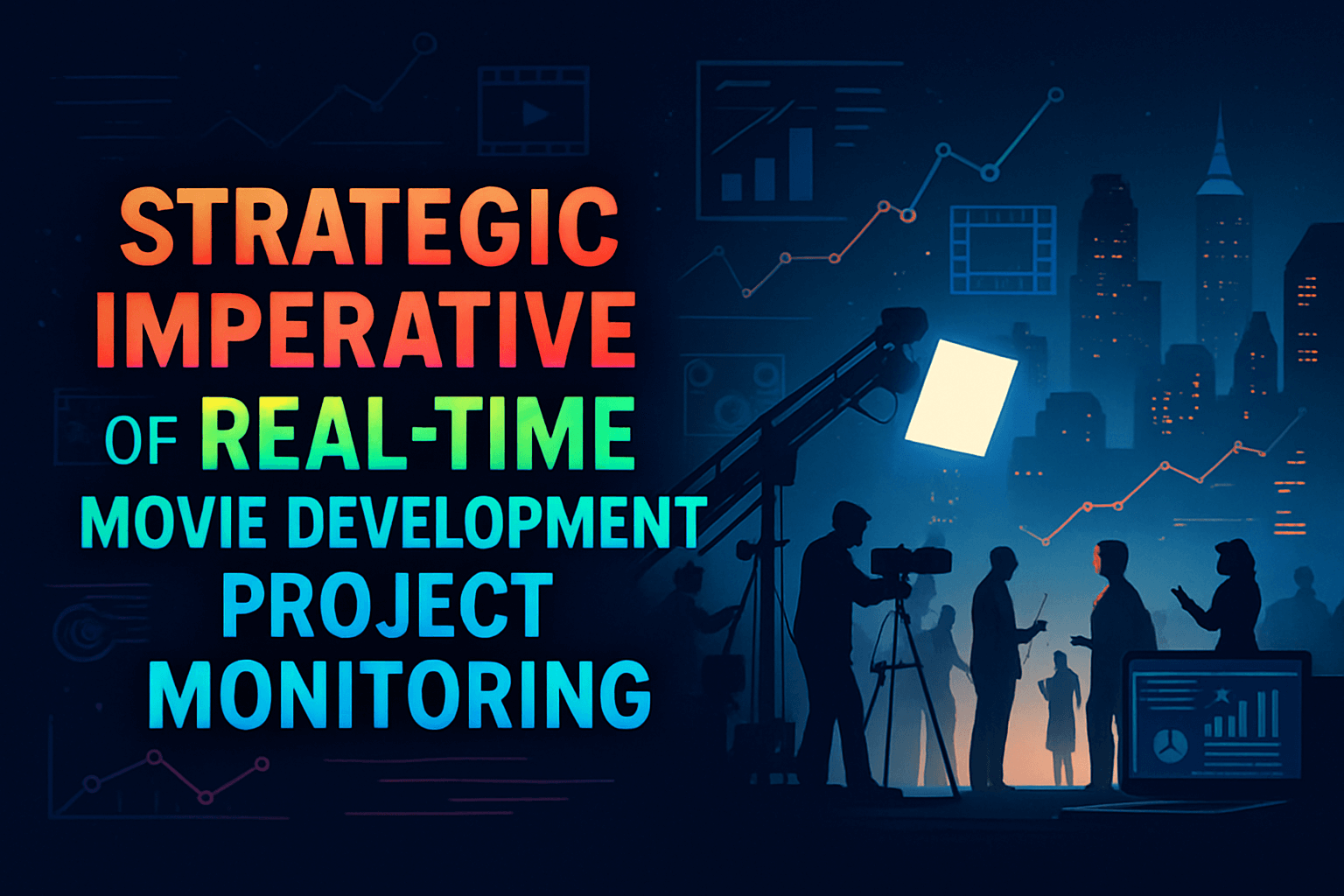The Strategic Imperative of Real-Time Movie Development Project Monitoring

Introduction
The traditional model of film and television development has long been an exercise in opacity. For M&E executives, visibility into the project pipeline has historically been limited, fragmented, and reactive.
A single-line summary of a project might appear on a trade publication, but the deeper, more actionable intelligence—who is attached, who is financing, and what is its true development status—remains locked away in disparate, often manual, data silos.
This lack of early warning creates a significant strategic gap. Executives are forced to rely on personal networks and late-stage market signals, often missing crucial windows for content acquisition, co-production deals, or proactive vendor outreach. This is the core challenge.
The strategic solution is a shift towards real-time movie development project monitoring. This is not about simple tracking; it is about leveraging comprehensive, daily updated data to gain a proactive, strategic advantage.
By connecting projects to the companies, collaborators, and transactions behind them, executives can transform their operational model from reactive to predictive.
Vitrina’s role is to provide the technology that makes this strategic shift possible. The platform aggregates, verifies, and connects millions of data points from the global entertainment supply chain, enabling M&E professionals to execute this new, more intelligent approach to content scouting and business development.
Table of content
- The Problem with Traditional Film Development Tracking
- What Is Real-Time Movie Development Project Monitoring?
- The Strategic Imperative for M&E Executives
- The Role of Technology: A Look at the Vitrina Platform
- How Vitrina Transforms Project Monitoring into a Competitive Advantage
- Conclusion: The Future of Project Monitoring Is Proactive
- Frequently Asked Questions
Key Takeaways
| Core Challenge | Fragmented, late-stage data hinders proactive decision-making in the entertainment pipeline. |
| Strategic Solution | A holistic, data-driven approach to tracking projects from development to release in real-time. |
| Vitrina’s Role | The Vitrina platform provides the centralized data and intelligence required to execute this strategy. |
The Problem with Traditional Film Development Tracking
The conventional approach to tracking film and television projects is inefficient, manual, and fraught with risk. It relies heavily on a combination of fragmented sources, including trade publications, personal networks, and manual spreadsheets.
While trade publications are essential for breaking news, they offer a retrospective view. By the time a project is announced, it is often too late for early-stage negotiations on financing, pre-buys, or co-production partnerships.
Relationships are vital, but they cannot provide comprehensive market coverage, creating blind spots, especially for projects in emerging markets or with new collaborators.
Executives often build their own ad-hoc tracking systems, but these are labor-intensive to maintain and quickly become outdated, preventing cross-functional teams from having a single, unified view of the market.
This reactive model leads to a number of critical pain points for executives, making it difficult to identify and secure high-potential content, find vetted partners, or build a strategic business development pipeline.
What Is Real-Time Movie Development Project Monitoring?
Real-time movie development project monitoring is a strategic practice that moves beyond simple data collection. It is the continuous, automated tracking of a project’s lifecycle, from its earliest stages of concept and development through to its production, post-production, and release.
This process, enabled by sophisticated technology platforms, ensures that M&E executives have a continuously updated, holistic view of the global content pipeline.
The key components that define a true real-time monitoring system are: daily data aggregation from a wide array of global sources; comprehensive, rich metadata on genre, budget range, and intellectual property; and a living network that links a project to its key collaborators—including production companies, financiers, distributors, and specific executives.
Unlike a static list of released films, real-time monitoring provides a living map of the industry. It is a system that not only tells you what projects exist, but also who is involved and where they are in the development process, allowing you to move from simply observing the market to actively participating in it.
The Strategic Imperative for M&E Executives
For senior leaders in the M&E space, the shift to a real-time monitoring strategy is not just an operational improvement; it is a competitive necessity. This approach provides a decisive advantage across a range of business functions.
For Content Acquisition & Distributors, real-time monitoring serves as a critical early warning system. By tracking projects in their nascent stages, executives can identify and secure pre-buy opportunities for films and series with high market potential.
For Production Financiers & Co-Producers, the ability to access a global, verified database of projects and collaborators is a fundamental change, allowing them to quickly find and vet potential co-production partners who have a proven track record in specific genres or territories.
For Vendor Services (e.g., VFX, post-production, localization), this strategic approach transforms business development. Instead of casting a wide net, they can precisely identify new business leads and initiate conversations with the right decision-makers at the exact stage when their services are needed.
The Role of Technology: A Look at the Vitrina Platform
Executing a sophisticated real-time monitoring strategy requires a technology platform built for the complexities of the global entertainment supply chain. Vitrina is designed to be that platform, serving as a centralized, living database for the industry.
The core of Vitrina’s capability lies in its Global Projects Tracker, a feature that provides a complete, 360-degree view of film and television projects at every stage of their lifecycle.
It automatically aggregates data from a vast network of global sources to provide a level of visibility previously unavailable. A key differentiator is Vitrina’s ability to map relationships between projects, companies, and people.
When a new project is greenlit, the system doesn’t just log the title; it links the project to the production company, the financier, the distributor, and the key executives involved.
This real-time movie development project monitoring provides a critical layer of context and allows users to see not just what is being made, but by whom and with what resources. Furthermore, Vitrina’s People Intelligence feature enables executives to identify and engage with the right contacts.
With over 3 million executives, crew heads, and dealmakers tagged by specialization, users can move beyond guesswork and cold calls.
How Vitrina Transforms Project Monitoring into a Competitive Advantage
By centralizing and structuring global entertainment data, Vitrina transforms project monitoring from a tedious, reactive task into a strategic, proactive function. Consider the following workflow transformation.
In the old model, a production financier might hear about a new project through a contact or a trade announcement, and then spend weeks manually researching the production company, its key players, and its deal history.
This is a fragmented, slow, and often fruitless process. With Vitrina, this workflow is compressed and automated. The financier can set alerts to be notified the moment a new project enters development with specific criteria—for example, a mid-budget sci-fi co-production in Europe.
The platform instantly provides a detailed profile of the project, including its current stage, the companies attached, and a map of their past collaborations. The financier can then use Vitrina’s People Intelligence to identify the decision-maker and initiate a conversation with an informed, data-backed pitch.
This dramatically accelerates the pace of business development and increases the probability of a successful deal. Vitrina also provides crucial insights for strategic planning.
An executive can monitor the development slates of competitors, identify emerging trends in intellectual property (IP), and track production financing and co-production models across the globe.
This level of market intelligence goes far beyond simple project tracking and provides the foundation for smarter, more confident business strategy. You can learn more about how Vitrina’s solutions provide a competitive edge. Discover how Vitrina helps you find your competitive advantage
Conclusion: The Future of Project Monitoring Is Proactive
The entertainment industry is at an inflection point. The traditional, analog methods of tracking the content pipeline are no longer sufficient in a globalized, data-rich market.
The future belongs to those who embrace a strategic, data-driven approach. Real-time movie development project monitoring is the practice, and platforms like Vitrina are the enabling technology.
By providing a centralized, continuously updated source of intelligence on projects, companies, and collaborators, it empowers M&E executives to move from a state of reactive discovery to one of proactive, data-informed opportunity capture.
It is the essential strategic shift for anyone serious about staying ahead in the global entertainment business.
Frequently Asked Questions
Project monitoring is the passive act of observing and tracking a project’s progress to ensure it aligns with the plan. Project control is the active process of managing deviations, taking corrective action, and adjusting the plan based on monitoring data to keep the project on track.
A production tracker is a tool or a list used to log the progress of a film or television project. While traditional trackers are often manual spreadsheets, modern systems are automated databases that provide real-time updates and richer, linked metadata on a project’s status.
Movie development can be tracked through a combination of methods, including monitoring official industry sources, news from trade publications, social media announcements, and using specialized technology platforms. The most effective approach is to use a centralized platform that aggregates this data in real-time.
Key challenges include dealing with fragmented, manual data sources, a lack of early visibility into projects, and the difficulty of verifying collaborator information. This leads to a reactive approach, which can cause executives to miss out on valuable opportunities.

























